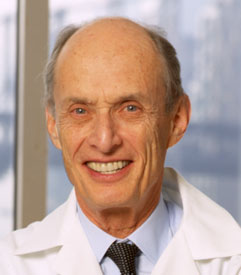Paul Greengard facts for kids
Quick facts for kids
Paul Greengard
|
|
|---|---|

Greengard in 2009
|
|
| Born | December 11, 1925 New York City, U.S.
|
| Died | April 13, 2019 (aged 93) New York City, U.S.
|
| Nationality | American |
| Spouse(s) | Ursula von Rydingsvard (second marriage, in 1985) |
| Children | 2 (by his first marriage) |
| Awards | Nobel Prize for Physiology or Medicine (2000) NAS Award in the Neurosciences (1991) Dickson Prize (1978) Metlife Foundation Award for Medical Research in Alzheimer's Disease (1998) |
| Scientific career | |
| Fields | neuroscience |
| Institutions | Rockefeller University |
Paul Greengard (December 11, 1925 – April 13, 2019) was an American neuroscientist. He was famous for studying how neurons (brain cells) work at a tiny, molecular level.
In 2000, Paul Greengard, Arvid Carlsson, and Eric Kandel won the Nobel Prize. They received this award for finding out how signals are sent inside the nervous system. Greengard worked as a professor at Rockefeller University. He also helped guide research for groups like the Cure Alzheimer's Fund. He was married to the artist Ursula von Rydingsvard.
Contents
Paul Greengard's Early Life and Education
Paul Greengard was born in New York City on December 11, 1925. His mother died when he was very young. His father was a comedian. Paul had an older sister named Irene.
During World War II, he joined the United States Navy. He worked as an electronics expert. He helped develop a warning system against enemy planes. This work was done at the Massachusetts Institute of Technology.
After the war, he went to Hamilton College. He studied mathematics and physics and graduated in 1948. He decided not to study physics further. This was because much of the research focused on nuclear weapons. Instead, he became interested in biophysics, which combines biology and physics.
Becoming a Scientist
Greengard started his advanced studies at Johns Hopkins University. He worked in the lab of Haldan Keffer Hartline. A lecture by Alan Hodgkin inspired him. Greengard then began to study how neurons work at a very small level.
He earned his PhD in 1953. After that, he did more research in London, Cambridge, and Amsterdam. Later, he became the head of biochemistry at Geigy Research Laboratories.
In 1967, he left Geigy. He worked at Albert Einstein College of Medicine and Vanderbilt University. Then, he became a professor at Yale University. In 1983, he joined Rockefeller University. He also helped guide research at other important science centers. Paul Greengard passed away on April 13, 2019.
Discoveries About Brain Cells
Paul Greengard's research focused on what happens inside neurons. Neurons are the cells that send messages in your brain. He studied how neurotransmitters (chemical messengers) affect these cells.
He and his team looked at "second messenger" systems. These systems change a signal from a neurotransmitter into lasting changes in the neuron. They found that when dopamine (a neurotransmitter) connects to a neuron, it increases a substance called cyclic AMP.
This increase in cyclic AMP then activates a protein called protein kinase A. This protein turns other proteins on or off. It does this by adding phosphate groups in a process called phosphorylation. These activated proteins can then make many changes in the cell. For example, they can make new proteins or change how sensitive the neuron is.
Greengard shared the 2000 Nobel Prize for this work. His discoveries helped us understand how the brain works. They also showed how some medicines affect brain function.
Paul Greengard's Family Life
Paul Greengard had two sons from his first marriage: Claude and Leslie Greengard. Claude is a mathematician and a business founder. Leslie is also a mathematician and computer scientist. He is a professor at New York University. Leslie has won many awards for his research. He is also a member of important science academies.
In 1985, Paul Greengard married Ursula von Rydingsvard. She is a famous sculptor. Her artworks are shown in major museums around the world. She has also received many awards for her art.
The Pearl Meister Greengard Prize
Paul Greengard used the money from his Nobel Prize to create a special award. It is called the Pearl Meister Greengard Prize. This award honors women scientists. He named it after his mother, who died when he was born.
The prize started in 2004. Greengard wanted to highlight the amazing achievements of women in science. He felt that women were not getting enough recognition for their work. This annual prize is given to an outstanding woman in biomedical research.
Awards and Recognitions
Paul Greengard received many honors during his life.
- He became a member of the National Academy of Sciences in 1978.
- He was also elected to the American Academy of Arts and Sciences in 1978.
- In 1991, he received the NAS Award in the Neurosciences.
- He was given the Golden Plate Award by the American Academy of Achievement in 2002.
- He received an honorary degree in Medicine from the University of Brescia in 2007.
- He was also a member of the Norwegian Academy of Science and Letters.
See also
 In Spanish: Paul Greengard para niños
In Spanish: Paul Greengard para niños

